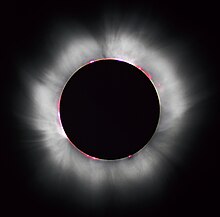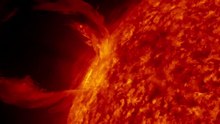Solar prominence

A prominence, referred to as a filament when viewed against the solar disk, is a large, bright, gaseous feature extending outward from the Sun's surface, often in a loop shape. Prominences are anchored to the Sun's surface in the photosphere, and extend outwards into the solar corona. While the corona consists of extremely hot ionized gases, known as plasma, which do not emit much visible light, prominences contain much cooler plasma, similar in composition to that of the chromosphere. The prominence plasma is typically a hundred times more luminous and dense than the coronal plasma.
All prominences form in filament channels above divisions between regions of opposite photospheric magnetic polarity called polarity inversion lines (PIL), polarity reversal boundaries (PRB), or neutral lines. They form over timescales of about a day and may persist in the corona for several weeks or months, looping hundreds of thousands of kilometers into space. Some prominences break apart and may then give rise to coronal mass ejections. Scientists are currently researching how and why prominences are formed.
A typical prominence extends over many thousands of kilometers; the largest on record was estimated at over 800,000 km (500,000 mi) long,[1] roughly a solar radius.
Historical[]

The first detailed description of a solar prominence was in 14th-century Laurentian Codex, describing the Solar eclipse of 1 May 1185. They were described as "flame-like tongues of live embers."[2][3]
Prominences were first photographed during the solar eclipse of July 18, 1860 by Angelo Secchi. From these photographs, altitude, emissivity, and many other important parameters were able to be derived for the first time.[4]
During the solar eclipse of August 18, 1868, spectroscopes were for the first time able to detect the presence of emission lines from prominences. The detection of a hydrogen line confirmed that prominences were gaseous in nature. Pierre Janssen was also able to detect an emission line corresponding to an at the time unknown element now known as helium. The following day, Janssen confirmed his measurements by recording the emission lines from the now unobstructed Sun, a task that had never been done before. Using his new techniques, astronomers were able to study prominences daily.[5]
Classification[]

There are a number of different prominence classification schemes in use today. One of the most widely used and basic schemes divides prominences into three classes based on the magnetic environment in which they had formed. These three classes are known as the active region prominences, quiescent prominences, and intermediate prominences.[6] Active region prominences are defined as those having formed within the relatively strong magnetic field at the centers of active regions, whereas, in contrast, quiescent prominences are defined as those having formed in the weak background field far from any active regions. In between these two lies the intermediate prominences defined as having formed between weak unipolar plage regions and active regions.
Active region prominences and quiescent prominences differ in fundamental ways. The former, as a consequence of only being located within active regions, are usually found in the lower latitudes whereas the latter are typically found in the higher latitudes around the polar crown.[7][8] Additionally, active region prominences, having lifetimes of only a few hours to days, are more eruptive than quiescent prominences which have lifetimes ranging from weeks to months.[9] Quiescent prominences generally reach much greater heights than active region prominences.
Active region and quiescent prominences can also be differentiated by their emitted spectra. The spectra of active region prominences is identical to that of the upper chromosphere having strong He II lines but very weak ionized metal lines. On the other hand, the spectra of quiescent prominences is identical to the spectra measured at 1500 km in the chromosphere with strong H, He I, and ionized metal lines, but weak He II lines.[10]
Eruption[]
Some prominences are so powerful that they throw out matter from the Sun into space at speeds ranging from 600 km/s to more than 1000 km/s.[11]
See also[]
| Wikimedia Commons has media related to Prominences. |
References[]
- ^ Atkinson, Nancy (6 August 2012). "Huge Solar Filament Stretches Across the Sun". Universe Today. Retrieved 11 August 2012.
- ^ "1185: The first description of solar prominences". Great Moments in the History of Solar Physics. Université de Montréal. 2008. Retrieved March 30, 2015. See pdf version here Archived 2015-04-02 at the Wayback Machine (accessed 21 August 2015).
- ^ Poitevin, Patrick; Edmonds, Joanne (2003). "Solar Eclipse Newsletter" (PDF). 8 (5). Patrick Poitevin. Retrieved March 30, 2015. Cite journal requires
|journal=(help) Original text cited at "Лаврентьевская летопись". Izbornik. Leningrad: USSR Academy of Sciences. 1927. p. 396. Retrieved 30 March 2015. - ^ Secchi, Angelo (1870). Le Soleil, Part 1. Paris. p. 378.
- ^ Vial, Jean-Claude (2015). Solar Prominences. Cham: Springer. pp. 1–29. ISBN 978-3-319-10415-7.
- ^ Engvold, Oddbjørn (1998). "Observations of Filament Structure and Dynamics". International Astronomical Union Colloquium. 167: 22–31. doi:10.1017/S0252921100047229.
- ^ Menzel, Donald H.; Jones, F. Shirley (December 1962). Solar Prominence Activity, 1944-1954.
- ^ Minarovjech, M.; Rybanský, M.; Rušin, V. (1998). "Time-Latitude Prominence and the Green Corona Distribution Over the Solar Activity Cycle". International Astronomical Union Colloquium. 167: 484–487. doi:10.1017/S0252921100048132.
- ^ Mackay, D. H.; Karpen, J. T.; Ballester, J. L.; Schmieder, B.; Aulanier, G. (April 2010). "Physics of Solar Prominences: II—Magnetic Structure and Dynamics". Space Science Reviews. 151 (4): 333–399. arXiv:1001.1635. doi:10.1007/s11214-010-9628-0.
- ^ Zirin, Harold; Tandberg-Hanssen, Einar (1960). "Physical Conditions in Limb Flares and Active Prominences. IV. Comparison of Active and Quiescent Prominences". The Astrophysical Journal. 131: 717–724.
- ^ "About Filaments and Prominences". solar.physics.montana.edu. Retrieved 2 January 2010.
Further reading[]
- Galsgaard, K.; Longbottom, A.W. (1999). "Formation of solar prominences by flux convergence". Astrophysical Journal. 510: 444. Bibcode:1999ApJ...510..444G. doi:10.1086/306559.
- Low, B.C.; Fong, B.; Fan, Y. (2003). "The mass of a solar quiescent prominence". Astrophysical Journal. 594 (2): 1060. Bibcode:2003ApJ...594.1060L. doi:10.1086/377042.
- Golub, L.; Pasachoff J.M. (1997). The Solar Corona. Cambridge University Press. ISBN 0-521-48535-5.
- Tandberg-Hanssen, Einar (1995). The Nature of Solar Prominences. Dordrecht: Kluwer Acad. ISBN 978-0792333746.
- Solar phenomena


